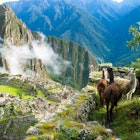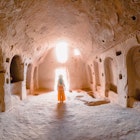

Hot air balloons in sky, Cappadocia, Turkey
Cappadocia, a dreamy slice of central Turkey dotted with 'fairy chimneys' (rock formations), has a history every bit as remarkable as its landscape. Volcanic eruptions created this surreal moonscape: the lava flows formed tuff rock, which wind and rain sculpted into sinuous valleys with curvy cliff faces and pointy fairy chimneys. Cappadocians chiselled homes in the soft rock, paving the way for cave-dwelling hippies and today’s boutique fairy-chimney hotels.
- placement: fullWidth
- path: articles/in-content-top
- possible size: [970, 250], [970, 90], [728, 90], [300, 250], [320, 50], [1, 1],
- targeting:
{ "url": "cappadocia-turkeys-land-of-fairy-chimneys", "destination": "Cappadocia", "continent": "Europe", "country": "Türkiye", "region": "Cappadocia" }
The area’s most extraordinary phase was during the medieval era, when the valleys were a refuge for Byzantine Christians. The religious troglodytes established monastic settlements, and their cave churches add a biblical solemnity to the Flintstones-like region. The Göreme Open-Air Museum, a World Heritage site, has the best collection of chapels and living quarters, most dating to around the 11th century.
Here are some must-see and must-dos while you're in the area:
Byzantine frescoes
Despite centuries of weathering and vandalism, many of the frescoes (or more accurately seccos, painted on dry rather than wet plaster) are glorious, colourful sights. The Dark Church has the best examples: multicoloured angels cover the pillars and vaulted ceilings, along with scenes such as the birth of Jesus, with an ox and ass poking their noses into the manger. As the church’s name suggests, the lack of light has preserved the representations, which still look fresh and vivid after a millennium.
- placement: fullWidth
- path: articles/in-content-middle
- possible size: [970, 250], [970, 90], [728, 90], [300, 250], [320, 50], [1, 1],
- targeting:
{ "url": "cappadocia-turkeys-land-of-fairy-chimneys", "destination": "Cappadocia", "continent": "Europe", "country": "Türkiye", "region": "Cappadocia" }
Other monastic complexes nestle in the valleys, many recalling Star Wars backdrops (but don’t believe mischievous guides who claim Chewbacca was ever here). The most popular for a stroll is Ihlara Valley - filled with riverside greenery, birdsong and a string of churches cut into the base of towering cliffs.
Explore underground cities
The local Christians were persecuted, first by the Romans and then raiding Muslims, and they often had to hide from hostile forces. When they heard hoof beats, they would abandon the cave churches and go underground - quite literally. Beneath Cappadocia’s rock formations is a network of subterranean cities, which housed up to 10,000 people each. The largest discovered are almost ten levels deep, with narrow passages connecting the floors like hamster tunnels.
Touring the cities, you pass stables with handles used to tether the animals, churches with altars and baptism pools, walls with air circulation holes, granaries with grindstones and blackened kitchens with ovens. The ventilation shafts were disguised as wells, and chunky rolling-stone doors served as last lines of defence. Not many artefacts remain - the inhabitants took their possessions when they returned to the surface - but the cities give a sense of life continuing in tough conditions.
Live like a troglodyte
Staying in Cappadocia today doesn’t involve any hardship or subterranean chambers. Many cave dwellings and fairy-chimney chapels have been converted into boutique hotels, where you can try the troglodyte lifestyle in luxury. Features include cave hamams (Turkish baths), rock-cut arches, walls patterned with volcanic colour-banding and panoramic terraces surveying the valleys. You’ll quickly discover what the locals have known for centuries: the tuff rock keeps rooms cool in summer and warm in winter.
- placement: native
- path: articles/in-content-native
- possible size: [f, l],
- targeting:
{ "url": "cappadocia-turkeys-land-of-fairy-chimneys", "destination": "Cappadocia", "continent": "Europe", "country": "Türkiye", "region": "Cappadocia" }
The allure of tourist dollars has tempted many Cappadocians away from agriculture. The pigeon houses riddling the rock faces - traditionally used to collect the birds’ droppings for use as fertiliser - mostly stand empty. Nonetheless, village life continues and vestiges of the fabulous past remain - including the local wine. Cappadocia has one of the world’s oldest wine industries, which stretches back some 4000 years to the Hittites - the first to recognise the volcanic soil’s viticultural qualities, and to carve rock cellars. As you sample the Anatolian grape, there’s certainly a great deal of history to reflect on in this land of fairy chimneys and Byzantine remains.
How to
Turkish Airlines flies from Istanbul to Nevşehir, Cappadocia. It also flies to nearby Kayseri from Istanbul, as does Anadolu Jet, while Pegasus Airlines flies from both Istanbul and Izmir and Sun Express flies from Germany. Daily buses from Istanbul take about 11 hours (normally overnight).
Visit the churches and underground cities early in the morning, at midday or near closing to bypass the tour groups. Particularly at the underground cities, a guide is beneficial as they can explain what happened in the bare stone chambers.
Read more at Lonely Planet's top 10 unmissable experiences in Istanbul.
- placement: fullWidth
- path: articles/bottom
- possible size: [970, 250], [970, 90], [728, 90], [300, 250], [320, 50], [1, 1],
- targeting:
{ "url": "cappadocia-turkeys-land-of-fairy-chimneys", "destination": "Cappadocia", "continent": "Europe", "country": "Türkiye", "region": "Cappadocia" }
Explore related stories








 HistoryHere's what you can expect on a Lonely Planet Experiences tour of Turkey
HistoryHere's what you can expect on a Lonely Planet Experiences tour of TurkeyMar 9, 2020 • 6 min read
 ArchitectureThe ultimate guide to Tibetan Buddhist monasteries: exploring gompas in the Himalayas
ArchitectureThe ultimate guide to Tibetan Buddhist monasteries: exploring gompas in the HimalayasNov 22, 2024 • 7 min read
